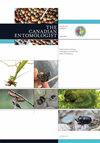青花田鼠和下花田鼠交配行为的野外调查
IF 1.1
4区 农林科学
Q3 ENTOMOLOGY
引用次数: 19
摘要
摘要本文研究了美国五大湖地区白蜡树(油桐科)林分中subcinctus Gory和cyanescens Ratzeburg的寻偶行为。这两种植物的死标本都被贴在灰树叶上,作为模型来测试雄性对空中吸引的视觉刺激。这些模型在二氯甲烷中清洗以去除表皮脂质,或者不清洗,以测试近距离信息素线索的存在。这两个物种的雄性都通过视觉引导从雌性上方1米的空中接近雌性,与Fairmaire Agrilus planipennis的行为相似。当雌性和雄性接触时,接触性信息素对随后的交配行为起调节作用。在视觉介导的空中下降和降落过程中,雄性青色棘球蛾直接降落在雌性模型上;而雄斑蝽则更多地落在支持模式的叶片表面。雄性亚cintus在用触角评估表面化学线索后,对雌性模型进行交配前突袭行为。雄性cyanescens降落在多种模型上,但降落后,拒绝了大量缺乏雌性cyanescens表皮脂质的模型。本文章由计算机程序翻译,如有差异,请以英文原文为准。
Field Investigation of Mating Behaviour of Agrilus cyanescens and Agrilus subcinctus
Abstract
We examined mate-finding behaviour in Agrilus subcinctus Gory (Coleoptera: Buprestidae) and Agrilus cyanescens Ratzeburg (Coleoptera: Buprestidae) in ash (Fraxinus L. (Oleaceae)) stands in the Great Lakes region of the United States of America. Dead specimens of both species were affixed to ash foliage to serve as models to test visual stimulation of aerial attraction of males. The models were washed in dichloromethane to remove cuticular lipids or were left unwashed, to test for the presence of close-range pheromonal cues. Males of both species located females via a visually guided aerial approach from up to 1 m above females, similar to the behaviour of Agrilus planipennis Fairmaire. When male A. subcinctus or A. cyanescens made contact with females, contact sex pheromones mediated subsequent copulation behaviour. During their visually mediated airborne descent and landing, male A. cyanescens landed directly on female models; whereas, male A. subcinctus landed significantly more often on the leaf surface supporting a model. Male A. subcintus performed precopulatory pounce behaviour on female models after assessing surface chemical cues with their antennae. Male A. cyanescens landed upon a variety of models, but after landing, rejected a significant proportion of models lacking female A. cyanescens cuticular lipids.
求助全文
通过发布文献求助,成功后即可免费获取论文全文。
去求助
来源期刊

Canadian Entomologist
生物-昆虫学
CiteScore
2.20
自引率
11.10%
发文量
24
审稿时长
6-12 weeks
期刊介绍:
French translation follows/le français suit Published since 1868, this peer-reviewed bimonthly publication is the official journal of the Entomological Society of Canada. Available via the internet and with hardcopy distribution to 55 countries, its research papers and notes are relevant to entomologists and other biologists around the world. In addition to being a venue for topical reviews and forum discussion, The Canadian Entomologist publishes current research in all facets of entomology, including systematics and morphology, molecular and developmental biology, ecology and behaviour, biodiversity and evolution, insect management, entomological techniques, and other relevant subject areas. Contributions are published in English or French. Authors will not pay page charges, and will experience fast, high quality reviews of their papers.Publiée depuis 1868, cette publication bimestrielle avec comité de lecture est la revue officielle de la Société d’entomologie du Canada. Disponible sur Internet et distribuée en format papier dans 55 pays, ses articles de recherche et ses notes sont pertinents pour les entomologistes et autres biologistes de par le monde. En plus d’être une plate-forme pour des revues thématiques et un forum de discussion, The Canadian Entomologist publie la recherche actuelle sur toutes les facettes de l’entomologie, incluant la systématique et la morphologie, la biologie moléculaire et développementale, l’écologie et le comportement, la biodiversité et l’évolution, la gestion des insectes, les techniques entomologiques et d’autres domaines pertinents. Les contributions sont publiées en français ou en anglais. Les auteurs ne paient aucun frais de publication, et recevront une révision rapide et de grande qualité de leurs articles.
 求助内容:
求助内容: 应助结果提醒方式:
应助结果提醒方式:


